How to Feed My Cat the Right Proportion of Dry and Wet Food When Shes on a Diet
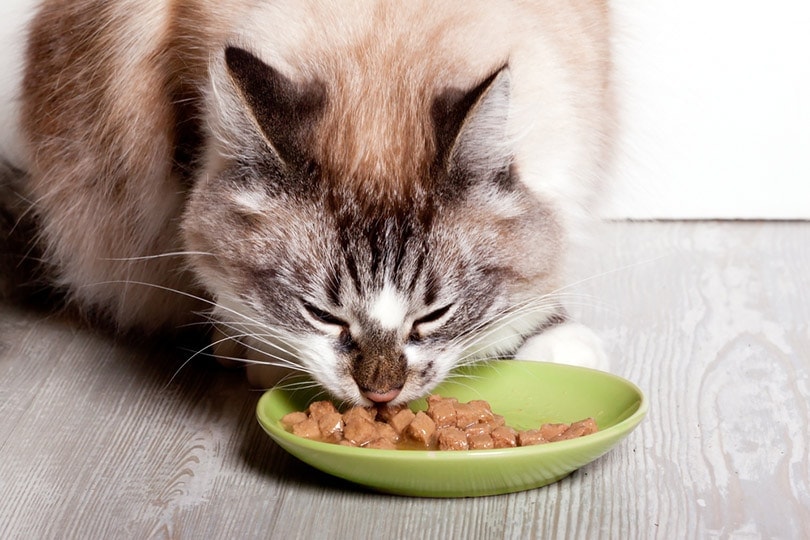
Commercial cat food comes in both wet and dry forms. Both types of food have benefits. For example, dry food (kibble) may help improve your pet's oral health and is more convenient to feed, while wet food has much higher water content. Wet food may increase a cat's water intake as cats naturally obtain much of their water from their food. This may be beneficial for cats with urinary tract problems, kidney issues, or general dehydration. Wet food may also be beneficial for overweight cats as it is less energy-dense.
Many first-time cat owners wonder whether it's important to feed their cat wet food, dry food, or a combination of the two. The truth is, that it is a personal choice. All good-quality cat food brands are developed to support every aspect of a cat's nutritional needs. The important thing is to ensure that you are feeding your cat the correct amount of food in order to meet his or her daily energy requirements.
How Much Wet Food to Offer Your Cat – 6 Steps
It can be a daunting task trying to figure out how much wet food to feed your cat. Some wet food feeding guides are vague, others give generalized feeding recommendations, which may not be appropriate for a particularly large or small cat, while some don't give guidelines at all.
All cats are unique and so are their daily feeding requirements. Let's calculate your cat's personalized plan using the steps outlined below.
1. Weigh Your Cat
Determine your cat's weight by weighing it at home or at the vet. The most accurate way to weigh your cat at home is to first learn your own weight and then weigh the combined weight of both you and your cat. Hold your cat in your arms while standing on the scale to do this. Subtract your weight from the combined weight. This will give you your cat's weight.
You'll need to know your cat's weight in kilograms for the calculation in the next step. If your scale only reads in pounds, convert your cat's body weight from pounds to kilograms by dividing the weight in pounds by 2.2.
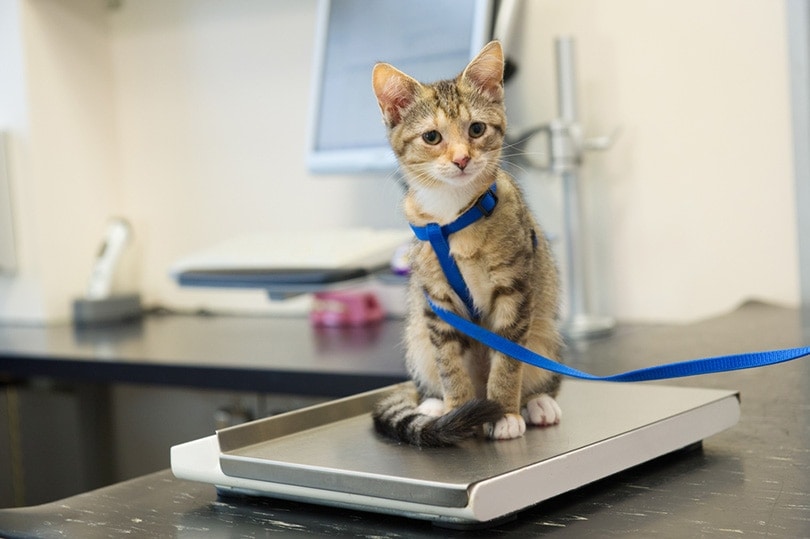
2. Calculate Your Cat's Resting Energy Requirement
The resting energy requirement or RER is the energy required for a cat to sustain essential bodily functions such as respiration, digestion, metabolism, and circulation, while at rest in a thermoneutral environment.
Technically, the formula used to calculate the resting energy requirement is:
- RER (kcal/day) = 70 x (BWkg)^0.75
There is, however, an easier way to do this by using the table provided below.
| Weight (pounds) | Weight (kilograms) | RER (kilocalories) |
| 1 | 0.45 | 39 |
| 2 | 0.9 | 70 |
| 3 | 1.4 | 90 |
| 4 | 1.8 | 109 |
| 5 | 2.3 | 131 |
| 6 | 2.7 | 147 |
| 7 | 3.2 | 167 |
| 8 | 3.6 | 183 |
| 9 | 4 | 198 |
| 10 | 4.5 | 216 |
| 11 | 5 | 234 |
| 12 | 5.4 | 248 |
| 13 | 5.9 | 265 |
| 14 | 6.4 | 282 |
| 15 | 6.8 | 295 |
| 16 | 7.3 | 311 |
| 17 | 7.7 | 324 |
| 18 | 8.2 | 339 |
| 19 | 8.6 | 352 |
| 20 | 9 | 364 |
The answer will give you your cat's resting energy requirements per day in kilocalories or calories. Although it's confusing, the "kilo" in "kilocalorie" does not mean one thousand. The terms kilocalorie and calorie can be used interchangeably and you may encounter both on the packaging of your cat's food. We will use kilocalories or kcal going forward in this article.
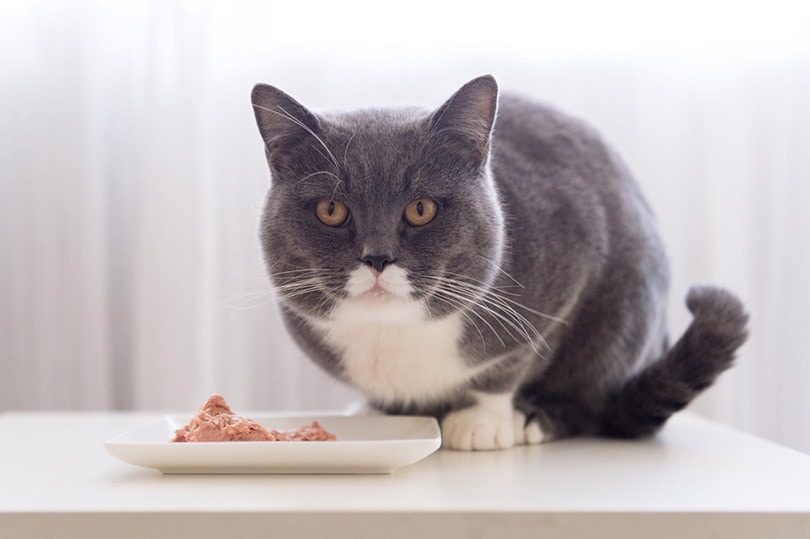
3. Calculate Your Cat's Maintenance Energy Requirements
While the resting energy requirement (RER) fulfills the basic energy requirements of a cat, it does not take into consideration factors such as life stage, body condition, physical activity, or whether a cat is intact or neutered. Animals with the same body weight can differ up to three times in their daily energy requirements due to these factors.
The maintenance energy requirement (MER) provides a more accurate estimate of a cat's daily energy requirements and is calculated by multiplying the calculated resting energy requirement by the coefficient based on life stage and body condition. In order to calculate your cat's MER, find the life stage and body condition that is most applicable to your particular cat in the table below. Multiple the corresponding coefficient by your cat's RER. The answer represents the number of kilocalories that your cat needs to eat in a day.
| Life stage / body condition | MER (kilocalories) |
| Growing kittens | 2.5 x RER |
| Neutered adult | 1.2 x RER |
| Intact adult | 1.4 x RER |
| Obese prone | 1 x RER |
| Weight loss | 0.8 x RER |
Remember that the MER is an estimate only and it's entirely possible that you will need to modify your individual cat's energy requirements based on their response. More on this in step 6.
4. Determine The Number Of Calories In Your Cat's Food
First, you will need to determine the amount of energy in a tin or pouch of your chosen wet food. The total amount of energy per tin or pouch is given in kilocalories and can be found on the label on the back of the packaging under the nutritional information.
If your cat is fed a diet of excessively wet food, stop here and continue to step 5.
If you feed a mix of wet food and kibble, you will need to determine the total energy content of the kibble that you feed your cat per day. As with wet food, you will find this information on the label on the back of the packaging under the nutritional information.
Giving your pet the highest quality nutrition is a top priority, so why not give them a food and water dish to match? The Hepper Nom Nom Bowl is our product, but it's too good not to share.
Made from food-safe stainless steel, you can ensure that your pet is consuming the best nutrition out of the finest bowls on the market. Click here to get yours.
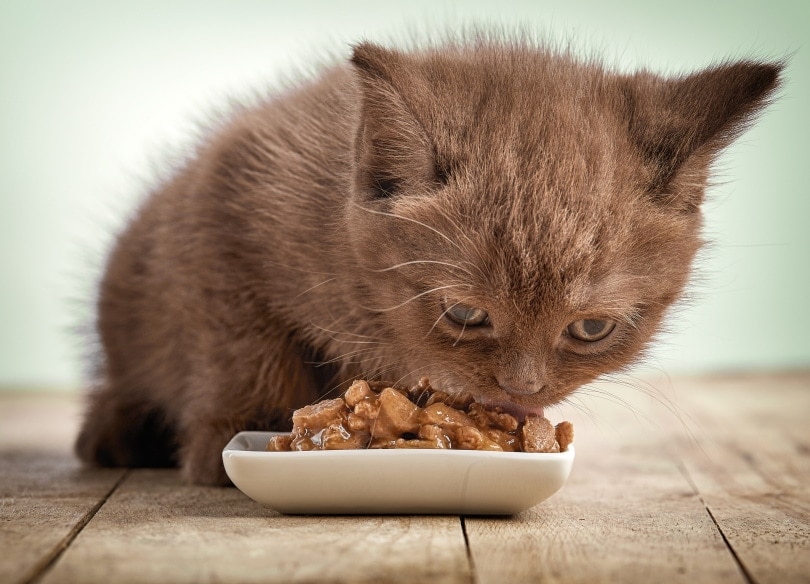
5. Determine The Exact Amount Of Wet Food To Feed Your Cat
If your cat is fed a diet of exclusively wet food, take your cat's maintenance energy requirement (MER) in kilocalories and divide it by the number of kilocalories found in a tin or pouch of wet food. The answer will give you the number of tins or pouches of wet food to feed per day.
If you are feeding a mix of wet and dry food, subtract the kilocalories found in the dry food from your cat's maintenance energy requirement (MER). Divide the answer by the number of kilocalories found in the wet food to obtain the number of tins or pouches of wet food to feed per day.
You may need to make adjustments to this last calculation by increasing or decreasing the total amount of kibble fed per day until you are satisfied with the amount of daily wet food to feed your cat.
It's important to also take into consideration any treats that you may feed your cat as this will reduce the total amount of energy they can obtain from wet and dry food. Treats should not form more than 5% of your cat's daily energy intake. Unlike wet and dry food, treats are usually not nutritionally complete, and feeding too many snacks can lead to nutritional deficiencies.
Whatever the split, ensure that the total number of kilocalories fed equals your cat's maintenance energy requirements.
6. Monitor Your Cat
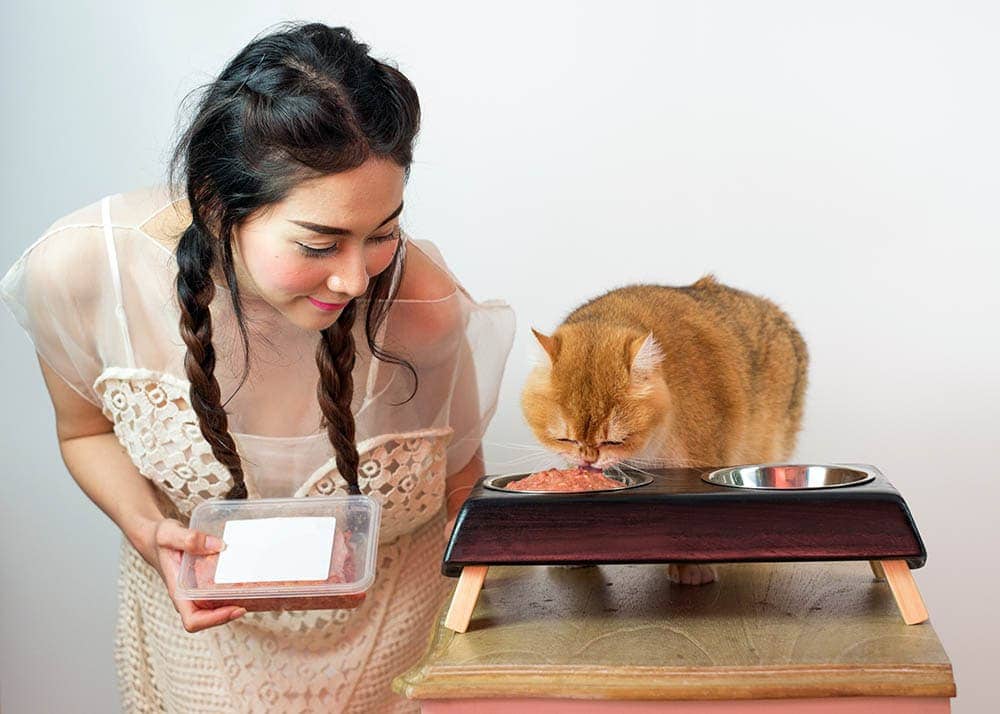
It's important to keep track of your cat's weight and body condition in order to make adjustments to their daily food allowance. As mentioned previously, the maintenance energy requirement (MER) is an estimate only. It is possible that you will need to modify your individual cat's energy requirements.
If your cat was an ideal weight but is now gaining or losing weight you should decrease or increase their daily maintenance energy requirement accordingly. Keeping track of your cat's weight is also important if you are trying to get your overweight cat to lose weight. It's dangerous for an overweight cat to lose too much weight in a short period of time. Cats can develop a potentially fatal condition called hepatic lipidosis, where fat is deposited in the liver from losing weight too quickly. Aim for gradual weight loss. A safe weight loss rate is about a 1%–2% loss of overall body weight per week.
If your cat loses or gains a significant amount of weight, you should get your cat checked by a veterinarian as it may indicate an underlying issue.
You will also need to make adjustments to your cat's maintenance energy requirement as he or she moves from one life stage to the next. For example, as kittens enter adulthood they stop growing and their daily energy requirements drop.
If this seems like too much work or math isn't your thing, there's a handy calculator which can be used to figure out your cat's maintenance energy requirement and the amount of wet food to feed per day.
Work Through An Example
Tom is a 3-year-old neutered male cat who weighs 10 pounds and is fed a diet of exclusively wet food. His owner would like to know how many sachets of wet food to feed Tom per day.
First, we'll convert Tom's weight to kilograms by dividing 10 by 2.205 which gives us an answer of 4.5 kg.
10 pounds / 2.205 = 4.5 kg
Now that we have Tom's weight in kilograms, we can work out his resting energy requirement using the formula RER (kcal/day) = 70 * (BWkg)0.75
RER (kcal/day) = 70 * (4.5)0.75 = 216 kcal/day
Tom's resting energy requirement is 216 kilocalories per day.
Alternatively, we could have used the table provided in step 2 to calculate Tom's resting energy requirement.
Next, we'll calculate Tom's maintenance energy requirements (MER) by selecting the appropriate factor from the table provided in step 3 and multiplying it by the RER. As Tom is a 3-year-old neutered male he, therefore, falls into the category "neutered adult" so we will select the corresponding factor of 1.2 from the table and multiply it by the calculated RER.
MER (kcal/day) = 1.2*RER
MER (kcal/day) = 1.2*216 = 259.2 kcal/day
Round up or down to the nearest whole number.
Our calculation shows that Tom's daily maintenance energy requirement is 259 kilocalories.
Tom is fed a diet of exclusively wet food. Each sachet of the high-quality, nutritionally complete wet food that his owner wants to feed contains 86 kcal. Divide Tom's daily maintenance energy requirement of 259 kcal by 86 kcal which is the amount of energy found in one sachet.
259 kcal / 86 kcal = 3
Based on our calculation, Tom needs to be fed three sachets of wet food per day to meet his maintenance energy requirement of 259 kcal.
How Often Should I Feed My Cat?
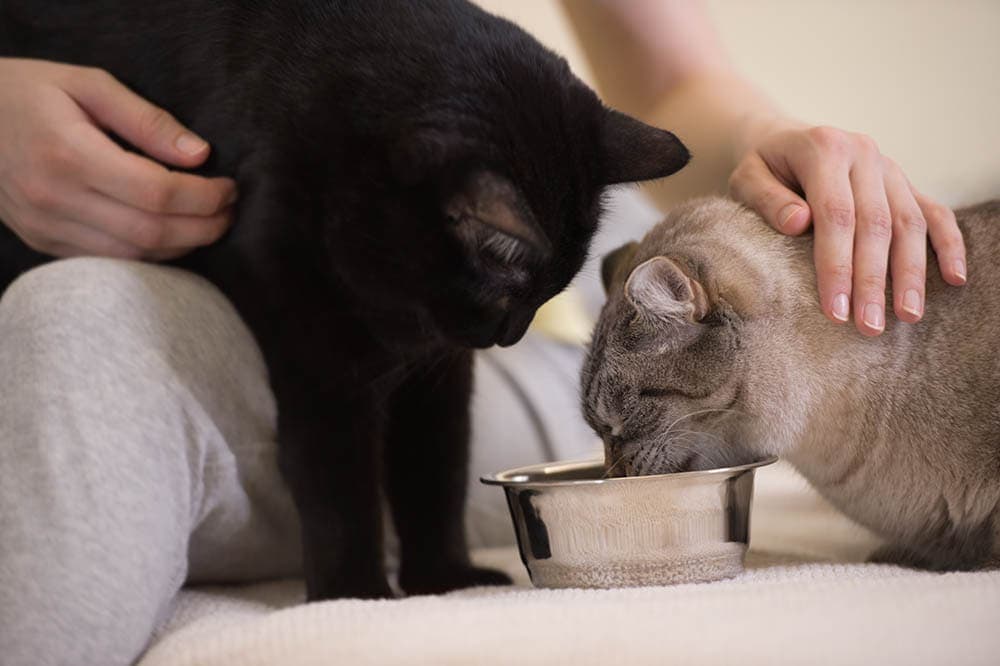
In the wild, cats are solitary hunters. This means that a cat's prey has to be small enough so that they can capture it alone. For the average size cat to meet its daily energy and nutritional requirements, it would have to kill and eat around 10 mice per day. Therefore, under natural circumstances, cats eat small, frequent meals throughout the day and night.
Based on a cat's natural feeding pattern, feeding one or two large meals is behaviorally and physiologically unnatural. It is therefore best to feed cats small amounts of food often to mimic their natural feeding patterns.
Feline experts in veterinary medicine, behavior, and health at International Cat Care have put together a feeding plan for cats called the 'Five-a-Day Felix' plan where they recommend feeding a cat five or more portions a day. You can read the report here.
How Can I Feed My Pet So Often?
While we all want what's best for our cat, being at home to feed your cat five meals a day is impractical due to work and other commitments. However, researchers have come up with a practical strategy to achieve this five-meal-a-day plan and recommend using timed feeders (set to release food at specific times) as well as puzzle feeders. This strategy also provides cats with mental and physical stimulation during feeding and allows them to express natural hunting behavior.
One possible solution would be to feed your cat wet food twice a day while you're at home and then use timed feeders for kibble to provide the remaining three meals. Just remember to lift the wet food after your cat is finished eating as wet food left out can spoil.
Everyone's situation is unique and it may just not be possible to feed your cat small meals often in which case it's advisable to feed at least two meals, no more than 12 hours apart. Kittens from 6 weeks of age should be fed at least three meals per day until they are 6 months old.
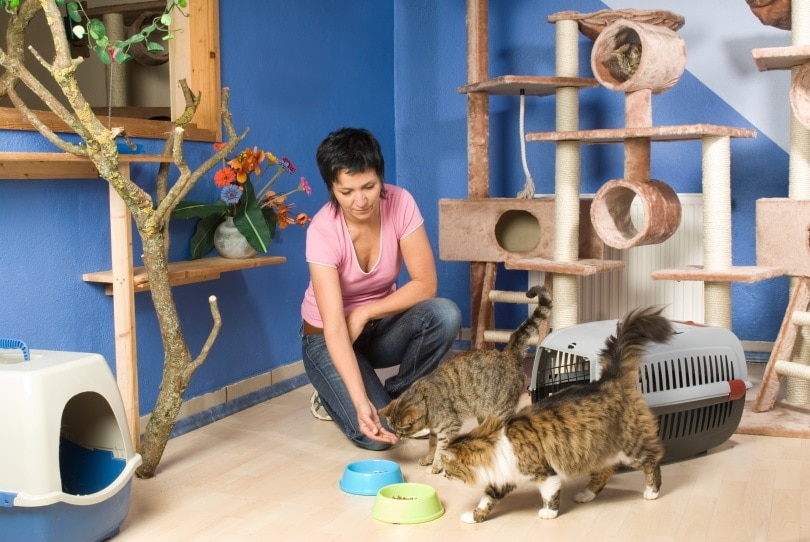
In Summary
The recommendations given in this article are just a starting point. Like us, cats are individuals and thus have unique energy requirements. The daily maintenance energy requirement will differ from one cat to the next. Weigh your cat and assess his or her body condition often and make dietary adjustments accordingly. Consult your local veterinarian or veterinary nurse for assistance.
Ensure that you are feeding your cat a good quality, nutritionally complete wet food. Feed your cat small meals as often as possible, aiming for five meals a day, presented in a way that is mentally stimulating. If this isn't possible aim to feed adult cats at least two meals per day, and kittens at least three meals per day.
Featured Image Credit: correct pictures, Shutterstock
Source: https://www.hepper.com/how-much-wet-food-to-feed-cat-vet-answer/
0 Response to "How to Feed My Cat the Right Proportion of Dry and Wet Food When Shes on a Diet"
Publicar un comentario